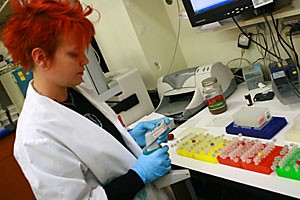A UA lab was chosen as a research partner for an international project that will match DNA from mass graves of Holocaust victims with DNA from living family members.
The Shoah Project, which is advised by Nobel Laureate James D. Watson, aims to establish a DNA database in order to assist European governments in identifying Holocaust victims. Shoah is the Hebrew term for Holocaust.
Matthew Kaplan, an ecology and evolutionary biology graduate student and research director for the Shoah Project at the UA, said researchers plan to create a massive DNA database out of cheek cells from the spouses and children of Holocaust victims.
Once the lab formulates a database composed of thousands of family members’ DNA, forensic scientists in Europe will begin to collect the DNA from bones found in the Holocaust mass graves, Kaplan said.
A DNA database can help identify Holocaust victims who were murdered by the Nazi regime and those who died from wartime-related causes. Most of the 6 million Jews who were killed were buried, not cremated, according to the Shoah Project Web site.
Kaplan said the UA was chosen to conduct the research for the Shoah Project because of its reputation for creating large-scale DNA productions, its strong background in human population genetics and its emphasis on the history of the Jewish population.
Michael Hammer, a UA research scientist who co-founded the project, said that retrieving and storing the DNA is easy, but getting the living survivors to remember and record their memories of missing relatives proves the more difficult task.
Survivors must remember where they last saw their relative and his or her birth date as well as any possible name changes of their relative during the Holocaust, Hammer said.
All of this information needs to be recorded electronically, and many of these survivors are 90 years old and their memories are fading, Hammer said.
The Shoah Project will begin within the next few months, and researchers in Hammer’s lab are feeling the pressures of time ticking against them.
“”There’s a sense of urgency here because the best DNA to match with the bones are found in those genetically closer to the victim, and we want to get DNA from the spouses and children before they die,”” said Barbara Fransway, a research specialist and recent UA graduate.
Kaplan said the project could last more than a decade, and he wants the public to understand the significant amount of time this project may take for families of Holocaust victims to see results.
“”People who watch CSI see researchers doing a weeks-long amount of work in a matter of 15 minutes, and the public doesn’t see that,”” said Kaplan.
Focus groups give presentations to Jewish community centers and Holocaust survivor groups across the United States to help publicize the project and collect cheek cell samples, Fransway said.
However, the project is still in the beginning stages, Fransway said.
Kaplan hopes that kits will be sent to victims’ families free of charge and with adequate instructions to take their own cheek cell samples and mail them directly to the lab.
UA undergraduates working in Hammer’s lab will also assist in the Shoah Project.
Geoff Goldberg, a molecular and cellular biology sophomore, is one of the students working on the project who said he recognizes the humanitarian significance of its mission.
“”This is totally different from just digging up old graves,”” said Goldberg, who is Jewish. “”A lot of Jews want to know what happened to their loved ones and want a sense of closure.””
Syd Mandelbaum, who co-founded the project with Hammer, is the son of two Holocaust survivors.
Fransway said one of Mandelbaum’s most adamant goals for the Shoah Project is to use science rather than solely literature to educate students about the Holocaust.
By using science as a discipline, an educational window will open so that the Holocaust will remain at the forefront of people’s minds, Fransway said.









